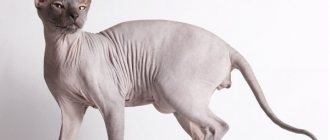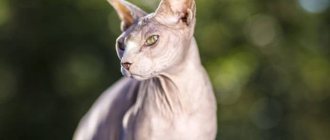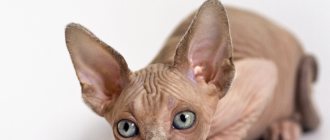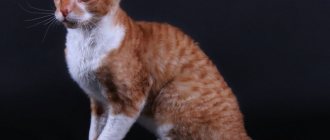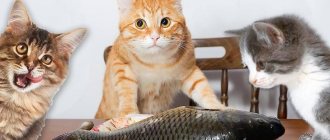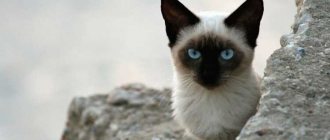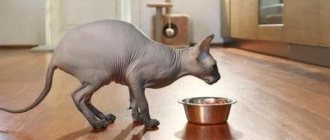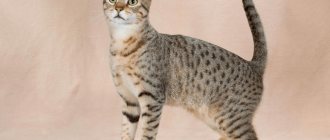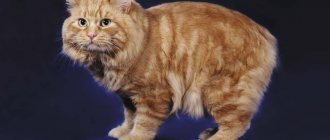History of the Canadian Sphynx breed
Canadian Sphynx
Although the breed is quite young, the existence of hairless cats is mentioned in the annals of various civilizations. The thing is that “bald” offspring can appear from completely ordinary parents as a result of a natural mutation. Most often, such animals were considered an anomaly and were discarded by humans.
There is evidence of the emergence in South America of an entire population of graceful creatures with amber-colored eyes. True, unlike Canadians, they could be partially covered with wool during the cold season, and wore mustaches all year round. It is impossible to judge the genetic characteristics of these animals today, since the breed has disappeared. The last individuals whose existence is documented lived in the 20s of the last century, but then “Inca cats,” as the Mexicans called them, did not interest professional breeders.
40 years have passed, and much further north, in the Canadian province of Ontario, the owner of a black and white short-haired cat named Elizabeth was surprised to find an unusual specimen in her pet’s litter. The kitten was given the name Prune (English: Prune) and, upon reaching maturity, was crossed with its own mother. The first experiments seemed successful, but already in the early 1970s the line was interrupted.
Around the same time, a new stage in the history of the breed began. In one of the catteries in Baden, Minnesota, two cats were devoid of fur at once. All modern elite lines trace their pedigree back to them, although the selection process, of course, included cats of different breeds. The best results were achieved by working with Devon Rexes; “naked” kittens, which were again discovered among our northern neighbors, actively participated in the creation of the breed. They were originally called “Canadian hairless cats,” but enthusiasts wanted something more sonorous and drew parallels with the oldest surviving monumental sculpture - the Egyptian Great Sphinx, which guards the peace of ancient rulers in Giza.
Recognition from international felinological organizations did not come immediately. There were concerns that the mutation was causing serious health problems. When time showed the inconsistency of these theories, The International Cat Organization (TICA) was the first to allow Sphynx dogs to participate in its exhibitions in 1986. After 6 years, champion status was received from the Canadian Cat Association (CCA), but the breed standard according to the authoritative The Cat Fanciers' Association (CFA) was approved relatively recently, in 2002.
History of the origin of the sphinxes
Sphynxes are one of the oldest cat breeds. There is evidence that they existed in ancient Egypt, when the white, blue-eyed sphinx guarded sacred places. The ancient Aztecs also had cats without hair; resourceful people used them as living hot water bottles.
Ancient breeds of hairless cats disappeared for various reasons, therefore, we can say that modern Sphynxes were bred artificially. For example, in the USA at the beginning of the 20th century, there was an exhibition where the Mexican hairless cat was shown - the closest relative of the ancient hairless cats. Unfortunately, the Mexican hairless disappeared completely by the thirties, because they could not leave productive offspring.
Hairless kittens can appear in furry cats, regardless of their breed. In 1938, biologist E. Letard from France began studying mutations that were observed in hairless kittens from a Siamese cat. In parallel, hairless cats had already been studied in Scandinavia and England, although these were only studies and not attempts to recreate the ancient breed.
The breed dates back to 1966, when another hairless kitten appeared in Canada from an ordinary domestic cat. The kitten was named Prune and was bred with its mother, resulting in both furry and hairless kittens. It was Prune who was crossed with his relatives in order to get as many hairless kittens as possible. However, the breed had not yet been formed, and the population was small. In addition, the kittens had weak immunity and often died.
The story of the Sphynx could have ended if in 1975 a hairless kitten had not appeared in Wadena from an ordinary short-haired cat. The kitten was ironically named Epidermis. Afterwards, a hairless cat was born there, and both individuals were placed in a nursery. This is how the Sphynx breed began - they successfully reproduced and gave birth to hairless kittens.
Appearance of the Sphinx
Sphynx kittens
Sphynxes are not large breeds. Females usually weigh 3.5-4 kg, males weigh between 5-7 kg. At the same time, the body is muscular and dense, which is why cats actually turn out to be heavier than one might expect given their size. The skin is thick and gathers into characteristic folds, especially pronounced on the muzzle.
Head
Medium in size, shaped like a slightly rounded modified wedge, where the length is slightly greater than the width. The forehead is flat, the transition from it to the muzzle can be either quite soft or clearly pronounced. The muzzle is short. The cheekbones are high and clearly defined. The chin is strong and forms a perpendicular to the upper lip. The nose is short, with a slight to medium stop. The whisker pads are well developed, although the whiskers themselves are completely or almost completely absent.
Ears
Ears are one of the distinctive features of the Canadian Sphynx breed. Very large compared to the head. Upright and open. The base is wide. The inner surface is without wool.
Eyes
The eyes of sphinxes are large, shaped like a lemon, because with a wide middle part they narrow equally on both sides. Set wide and slightly slanted. The color is not regulated, but must be in harmony with the color.
Neck
Medium length, slightly arched, with well-developed muscles.
Face of the Canadian Sphynx
Body
Sphynx paws
The body of the sphinx is of medium length, muscular. The chest is wide and rounded. The belly is round and full. The back of the body is rounded.
Legs
Medium length, proportional to the body. Strong and muscular. The hind ones are slightly longer than the front ones.
Paws
Oval, with thick pads and well-developed long toes.
Tail
White Sphynx
The length of the Sphynx's tail is proportional to its body. Graceful and flexible, gradually tapering from base to tip.
Cover and skin
The skin of the Canadian Sphynx is thick and forms folds, which are especially numerous on the face and legs. They seem completely hairless, but usually the body is covered with delicate down (a length of no more than 2 mm is allowed). The norm is the presence of short, sparse hair on the outside of the ears, tail, between the toes and in the scrotum area. The bridge of the nose is covered with the usual short hair for cats.
Color
Despite the lack of hair in the usual sense, sphinxes have many colors: white, black, red, chocolate, lilac (lavender), tabby, tortoiseshell, two-color, calico (tri-color), color point, mink. Neither conflicts with the CFA standard.
FEATURES OF THE BREED (external data)
Among the small number of hairless cat breeds, one of the most unique is the Canadian Sphynx
. These cats are most popular among people of creative professions, fashion and art workers, lovers of the unusual, and admirers of everything mysterious and mystical.
According to approved standards, an animal of this breed should be of medium size, the body must be muscular, round and strong.
Also, he has:
- massive and wide chest,
- round belly,
- the hind legs are slightly longer than the front legs,
- medium-sized wedge-shaped head,
- short muzzle,
- eyes shaped like a lemon and the distance between them is relatively large.
The skin color of this animal is usually in harmony with the color of its eyes. The size of the ears is comparable to the size of half the head; they are set wide apart and rounded at the ends.
The forelimbs with oval paws and long toes have a wide stance.
In general, skin folds are present on the forehead, neck, and also extremities.
Apart from the almost imperceptible fluff, these cats are completely hairless. Sphinxes are very warm and pleasant to the touch, like velvety suede.
The body temperature of Canadian Sphynx cats can reach 40 degrees.
Photo of the Canadian Sphynx
Diseases and health problems
Sphynxes have a very strong immune system, so with proper care they will not catch colds or suffer from infectious diseases. But these animals have a number of birth defects that can manifest themselves in one form or another.
For example, the so-called “carp bite”, in which the lower jaw of the sphinx is slightly shortened. Cats' incisors do not touch, the jaw becomes warped, and tooth asymmetry occurs. Due to the fact that the teeth dig into the hard palate, ulcers and wounds constantly appear on it.
There is also a disease called microphthalmia, in which kittens’ eyes develop incorrectly, causing them to decrease in size. This is fraught with many eye diseases that need to be monitored by a veterinarian. Sometimes cysts and tumors appear in the eyes. A similar disease is entropion of the eyelids, which causes animals to suffer from conjunctivitis for life.
Important fact: Curvature of the caudal spine is also not a rare occurrence among sphinxes. Often kittens are simply born non-viable and die early. This disease is fraught with intestinal abnormalities, a weak digestive system, short stature and underdeveloped thoracic region.
Nipple hyperplasia occurs among female Sphynx cats and is inherited. It usually affects cats with light blue or blue-cream skin and blue eyes. It is impossible to diagnose it immediately, but it appears gradually. At the age of one year, kittens' nipples turn red, and the skin around them gradually thickens. Cysts may appear.
Cats with this disease should not be bred. Cubs can be born with pathological internal organs, which is why they often die. These cats also produce very little milk. Hyperplasia can occur if a cat is given hormones that suppress sexual desire.
The character of the Canadian Sphynx
The ancient sculpture of a lion with a human head, lost in the African sands, was once called differently by Arabic speakers - Abu al-Haul, that is, the Father of Terror. But her little namesakes don’t seem at all intimidating to their owners. These are real “tails” that will follow a person everywhere and will not miss the opportunity to settle on his lap.
This sphinx has found its place
However, such affection is not at all an indicator of laziness. Sphinxes are very mischievous and playful creatures; they get involved in active fun with great excitement or independently come up with entertainment for themselves, such as “hunting” for a beetle that happens to be in the apartment. Games should be versatile and challenge not only dexterity and muscle strength, but also the intellect.
Sphinxes do not tolerate loneliness well, which should be taken into account by potential owners whose work involves frequent and long business trips. Canadians are attached not to a place, but to “their” people, so separation is a difficult test for them, even if in your absence the care of your pet is entrusted to reliable and kind hands.
Sphynxes are absolutely not aggressive, so they get along well with children of different ages and calmly share their home with other pets. Moreover, they know how to be friends with both cats and dogs, which helps brighten up the long hours of waiting to meet a person.
Representatives of this breed get used to being in large crowds of people quite easily. Thanks to this, sphinxes feel good at exhibitions, and some bring the skill of equanimity to such a level that they become real movie stars. The most striking example of this is Ted Nugent, who played the role of Mr. Bigglesworth, Dr. Evil's cat from the famous Austin Powers film series.
Character and habits of sphinxes
Sphynx cats really need human interaction, and this distinguishes them from many other cat breeds. They are loving, love to sit on laps, and enjoy being petted. The Sphynx does not like to be alone for a long time, so these cats are not suitable for people who are always busy at work.
Sphinxes are completely non-aggressive, friendly and friendly. They are ready to meet new people, willingly allow themselves to be petted and prefer not to show aggression. These cats are well suited for families with children, as they love to play and will never offend a person. You can choose to overcome obstacles as games with sphinxes - these cats are excellent at learning.
Interesting fact: Sphinxes do not have a tendency towards vengeance, and they are not at all vindictive. At the same time, sphinxes are extremely vulnerable animals, so you should treat them kindly and friendly. You should not yell at them, much less hit them, as this can make the cat depressed. Sphinxes easily get psychological trauma, which is why their life expectancy is reduced.
Sphinxes are very curious. They love to climb into inaccessible places in the house and always pay attention to new objects. Therefore, they should hide prickly and cutting things, since curious cats will definitely get to them.
The Sphinx will never perceive itself as inferior to a person. Only partnerships are possible with these cats, in which the sphinx is a full-fledged member of the family. Because of this, you should not expect that the Sphinx will unquestioningly obey and carry out commands. Therefore, it is generally accepted that these cats are characterized by stubbornness and pride.
Sphynxes get along well with other animals, they are not even afraid of dogs. At the same time, the sphinx will not be jealous of the owner of other pets if they devote enough time to everyone.
Care and maintenance
Having no hair may seem like a big advantage to a busy owner, but in fact, Sphynx cats require even more care than their furry counterparts. The sweat and sebaceous glands in these cats work in “normal mode”, so a kind of plaque forms on the surface of the skin, which provokes the appearance of greasy stains on the owners’ clothes, bedding and upholstery.
Canadian Sphynx in a sweater
To avoid this, hygiene procedures should be carried out regularly. Some people think that it is enough to wipe the cat’s body with wet wipes that do not contain alcohol or fragrances. But most agree that the optimal solution to the problem is weekly bathing with special mild products or baby shampoo. If you accustom a kitten to them from an early age, the process will happen quickly and without much hassle. Please note that immediately after a bath the sphinx must be wrapped in a towel!
The issue of hypothermia is generally quite acute for representatives of this breed. When you hold a hairless cat in your arms, it seems really hot. The fact is that due to the lack of a fur “buffer”, heat exchange with the external environment is much more active in them than in other animals. This means that in a cool room the sphinx will freeze no less than a naked person, so buying special clothes for winter and the off-season will not be superfluous even for permanent residents of city apartments.
By the way, experienced breeders recommend exclusively keeping Canadian Sphynxes at home. If you consider it necessary for your pet to stay in the fresh air, it is better to limit its duration and monitor the cat at all times. Independent walks are contraindicated not only because of the risk of colds or sunburn (yes, Sphynx cats can get tanned and burn, so in the summer they need sunscreen!). Thanks to its characteristic appearance, even a layman can easily recognize your pet as a purebred, which means a potentially expensive animal, which can lead to kidnapping.
We didn't find a house and organized it ourselves
Other care tips differ little from the standard ones. It is important to monitor the condition of the eyes and ears to avoid infections. Regular brushing of your teeth with a special paste guarantees protection from tartar, and trimming your nails will help keep your furniture and walls in their original condition.
The cat will be grateful for a personal “house” with the opportunity to climb higher and play hide and seek, but most sphinxes prefer the owner’s bed, where you can comfortably sit under a warm blanket, to a soft bed.
All sphinxes have an excellent appetite. This is another side effect of not having fur, as they require more energy than other cats due to their intense heat exchange. The main thing is that the quality of the food is at a high level and fully satisfies your pet’s needs for proteins, fats, carbohydrates, vitamins and minerals. The easiest way to achieve this balance is with specialized premium and super premium food. But if you are willing to spend time creating a healthy menu of foods, natural nutrition will be a worthy alternative.
Leftovers are sweet
Canadian Sphynx having a meal
Caring for a Sphynx cat
Eyes
The absence of eyelashes makes the Sphynx's visual organs especially vulnerable. To prevent inflammation, your cat's eyes should be wiped daily with chamomile infusion, chilled black tea, or simply boiled water. You can use special products from the pet store.
In ordinary cats, brown discharge in the ears indicates developing diseases. For Sphynx cats, brown plaque on the inner surface of the ear is normal. Once a week, the skin should be wiped with a cotton pad soaked in lotion. After cleaning, the ears are dried and powdered with a special product purchased from a veterinary pharmacy.
Bathing
Canadians need to be washed regularly, but not too often. The optimal regime for bath procedures is once every 14–30 days. For bathing, you can use a special shampoo. Products that are not suitable for Canadian skin may cause allergic reactions and inflammation.
Wash cats with a soft sponge or hand without gloves. Water temperature is 37–39 degrees. The temperature in the room where bath procedures are carried out is also important. You need to make sure that there are no flows of cold air.
Important! A common problem with Canadian Sphynx cats is neglect of anal hygiene. To prevent your pet from soiling objects in the house with fecal residue, you need to wipe its butt and tail with hypoallergenic wipes after using the toilet.
Claws
Canadians need a manicure once every 2 months. Use sharp nippers or rounded scissors to trim the tips of the claws. This procedure is mandatory. If the claws are not trimmed in a timely manner, the cat may injure itself and the skin will become inflamed.
Cold protection
Completely hairless, Canadians are not adapted to the harsh Russian climate. Cats are quite comfortable indoors, but they need special warming clothing to walk outside. It is also necessary to organize a warm bed for sleeping and rest. The best option is a closed house. Additionally, you can organize a comfortable hammock next to the heating radiator.
Health and illness of the Sphinx
Cute sphinx
In general, with the right diet and proper care, sphinxes are infrequent patients of veterinary clinics. Problems can be caused by hypothermia, prolonged exposure to the sun, neglect of hygiene rules on the part of the owners, and lack of immunity due to missed vaccinations.
But there are also breed-specific diseases. The weak point of Canadians is sensitive skin; it can be affected by urticaria pigmentosa. Redness and rashes on the body can also be symptoms of allergies, including food allergies. Only a doctor can determine the exact cause and prescribe treatment based on test results.
Like Maine Coons, Sphynx cats suffer from hypertrophic cardiomyopathy. This dangerous heart disease is caused by a genetic mutation, but to date there is no convincing evidence that heredity has a decisive influence on its development.
But another disease of sphinxes, myopathy, is transmitted to descendants from parents. They got it in the process of selective work with Devon Rex. Progressive muscle dysfunction has no cure, progresses individually and often leads to death as a result of laryngospasms. Usually appears at 4-7 weeks of age, but may be asymptomatic until 12-14 weeks. The nursery must warn you if the kitten is at risk.
Interesting facts about sphinxes
Contrary to popular belief, Sphynx cats are an ancient breed of cat, but this is not entirely true. Ancient hairless cats became extinct for various reasons, and sphinxes are an artificially bred breed that was created due to mutations.
Typically, Sphynx cats live for about 14 years. The longest living cat of this breed died at the age of 19 years. The key to success in the longevity of these cats is proper care and a minimum of stress.
Sphynxes are very hot animals, as their body temperature reaches 39 degrees Celsius. It was not for nothing that the ancient Aztecs used sphinxes as living hot water bottles. Given their temperature, cats of this breed are extremely heat-loving and cannot tolerate cold weather.
Sphynx cats are suitable for people who really want to have a cat, but are allergic to fur. The absence of hair is also a plus in caring for a pet. Sphynxes love to swim in warm water.
Newborn Sphynx cats have drooping ears, and their body is covered from head to toe with folds, some of which straighten out with age.
Hairless cats were considered sacred in many nations. Their gracefulness was glorified in antiquity, and the cult of cats in ancient Egypt did not bypass the oldest representatives of hairless cats.
Sometimes sphinxes do show aggression, but this is not the norm for their behavior. Aggressive sphinxes are cats that have suffered some kind of stress or received psychological trauma. Such cats should be gradually rehabilitated, but trust will be extremely difficult to restore.
Sphynx cats have very sensitive skin. They should definitely be stroked and scratched, as this gives them pleasure, makes them happy and even more attached to their owner.
How to choose a kitten
The main advice is the same for all purebred animals: do not try to save money on your purchase by going to the “bird market” or responding to a random ad. Only the best nurseries and breeders with an impeccable reputation will guarantee that you will receive a healthy pet, the origin of which cannot be doubted. After all, the Canadian Sphynx is not just a lack of hair, but a graceful, beautifully built, affectionate and intelligent creature that will live next to you for the next few years.
If you do not plan to participate in exhibitions, it is enough to make sure that the chosen baby is healthy and active, easily makes contact with people, without showing fear or aggression. The rest will be determined by the available documents (pedigree, veterinarian’s report, vaccination card). We recommend getting to know the parents and looking at the living conditions - they will say a lot about the breeder’s attitude towards the cats.
Feeding pets
The Sphynx cat has a large appetite and is an immoderate eater. They are prone to obesity, for this reason it is necessary to pay special attention to the pet’s nutrition and ensure that its diet is balanced and low in calories.
Animals of this breed practically do not chew, therefore it is recommended to feed them food of the appropriate consistency. The most favorable products for them:
- lean meat;
- vegetables;
- dairy products;
- raw chicken egg yolk;
- cereal porridge.
It is forbidden to give bald animals cheese, various sweet pastries, sausage and other similar products. It is best to feed your pets with special dry food, which can be purchased at any pet store or pharmacy.
Sphynxes should also be walked outdoors, but should not be taken out in cold or too hot weather. For walks in the cool season, it is recommended to purchase a suit or overalls for your pets.
These cats look like fairy-tale creatures. They make a lasting impression on people. Thanks to their unique charm, these creatures can be called one of the most sought after among cat lovers.
Photo of the Canadian Sphynx
How much does a Sphynx cost?
If you are offered to buy a Sphynx kitten for 3-4 thousand rubles, you can rest assured that there can be no talk of any pedigree here.
The price of kittens in trusted nurseries starts from 8-10 thousand rubles. Children who have more or less significant deviations from the breed standard are cheaper. They are perfect for those who dream of a pet with an extraordinary appearance and character.
Prospective exhibitors whose parents can boast of championship titles and other titles will cost their future owners at least 15 thousand rubles.
Breeding Sphynxes
Reproduction of Sphynx cats requires special attention, and breeding of cats of this breed should only be done by people who already have experience in breeding cats. It is important to know how Sphynx puberty proceeds, how to choose a partner for mating and how to deliver a cat so that everything goes well.
Cats mature around the seventh month of life, but it is still too early to start breeding them. It is important to wait out the first heat: the sphinx begins to scream and fuss. Changes occur in its behavior: cats can become both very affectionate and aggressive. The Sphynx's body is still developing, so you should just wait out this period if you are not going to sterilize the cat.
Males mature around the eighth month of life. They are not yet ready for mating - readiness can also be understood by a change in behavior: the pet is actively marking its territory and becoming aggressive.
The first mating can be carried out after the cats are one and a half years old - during this time the cat goes through at least three heats. By this age, animals must be fully vaccinated and healthy, otherwise there is a risk of getting sick offspring. Cats cannot be vaccinated after mating.
Before mating, animals must be checked by veterinarians to ensure that there are no accidental diseases. Before mating, the animals' claws are trimmed so that they do not accidentally fight. It is better to give the cats time to get used to each other a little and get to know each other. The smell of the cat should attract the male, so everything will go naturally. Sometimes mating alone is not enough, so cats must spend several days with each other.
Pregnant cats become lazy and affectionate. Pregnancy lasts 63 days, but delayed births are not uncommon among this cat breed. Sphynx cats usually give birth on their own without complications. In general, a cat can bear up to 12 healthy kittens. Kittens are born healthy and strong, and open their eyes very early.
